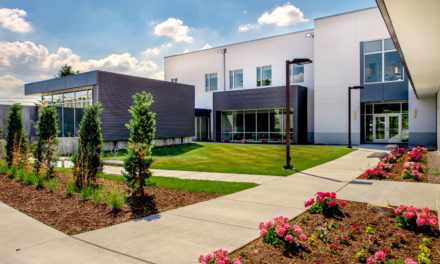State-of-the-art facility houses one of the largest suites of art-conservation spaces of any public museum; completes second phase of Museum’s unifying campus-redevelopment plan
The Museum of Fine Arts, Houston, announced October 24, that it has finished the second phase in its multi-year campus redevelopment plan with the completion of the Sarah Campbell Blaffer Foundation Center for Conservation. The 39,000-square-foot, state-of-the-art facility by Lake|Flato Architects brings the Museum’s distinguished conservation teams together on the main campus for the first time, in one of the largest, continuous spaces for conservation of any public museum.
The MFAH has received $750,000 in renewed art-conservation funding from The Andrew W. Mellon Foundation. This grant will be overseen by David Bomford, chairman of the MFAH department of conservation; and Andrew W. Mellon Research Scientist Corina Rogge. It supports a continuing collaboration between the MFAH, the Menil Collection, and Rice University to share resources, research, and expertise initiated in 2006 and recently expanded to the University of Houston.
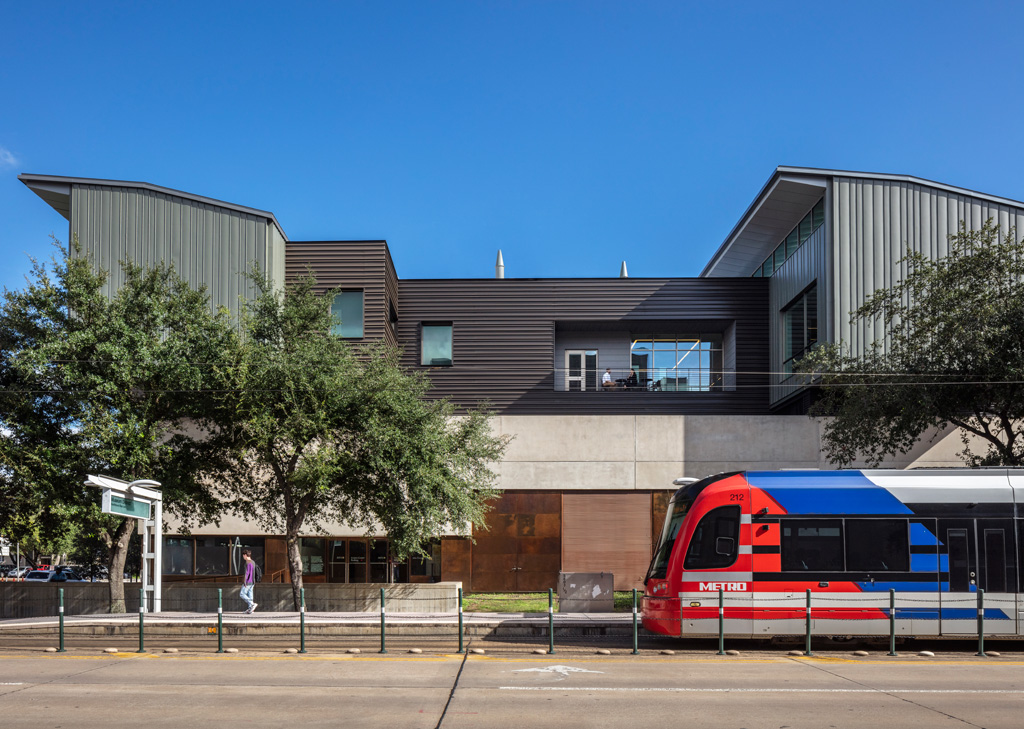
Profile view of the Sarah Campbell Blaffer Foundation Center for Conservation by Lake|Flato Architects from Fannin Street. Photograph © Richard Barnes
Research begun under the collaboration has since been extended to working with museums nationally, including the Getty Conservation Institute, the Metropolitan Museum of Art, the Museum of Modern Art, Harvard Art Museums, and the Art Institute of Chicago.
Gary Tinterow, director of the MFAH, said, “The new Blaffer Foundation Center for Conservation—one of just a handful of purpose-built museum conservation buildings anywhere—dramatically elevates our conservation facilities to the distinguished level of our extraordinary art conservators and scientists. The completion of the center also brings us one step closer to our goal of unifying the Museum’s facilities into one contiguous, 14-acre main campus in 2020.” That campus transformation is the largest cultural project currently under way in North America, with some 500,000 square feet in new construction.
“Our team can now easily collaborate across all areas of the MFAH—from the collections on the main campus to those in our decorative-arts house museums, Rienzi and Bayou Bend Collection and Gardens—using the most advanced technology in a space that was designed with the conservation and care of the Museum’s varied collections specifically in mind,” said Dr. Bomford. “Hand-in-hand with the new facility, the Mellon grant now assures that the Museum can continue to support and share the expertise that Dr. Rogge has brought to our projects and initiatives, in particular those addressing the materials, treatments, and techniques of 20th- and 21st-century art.”
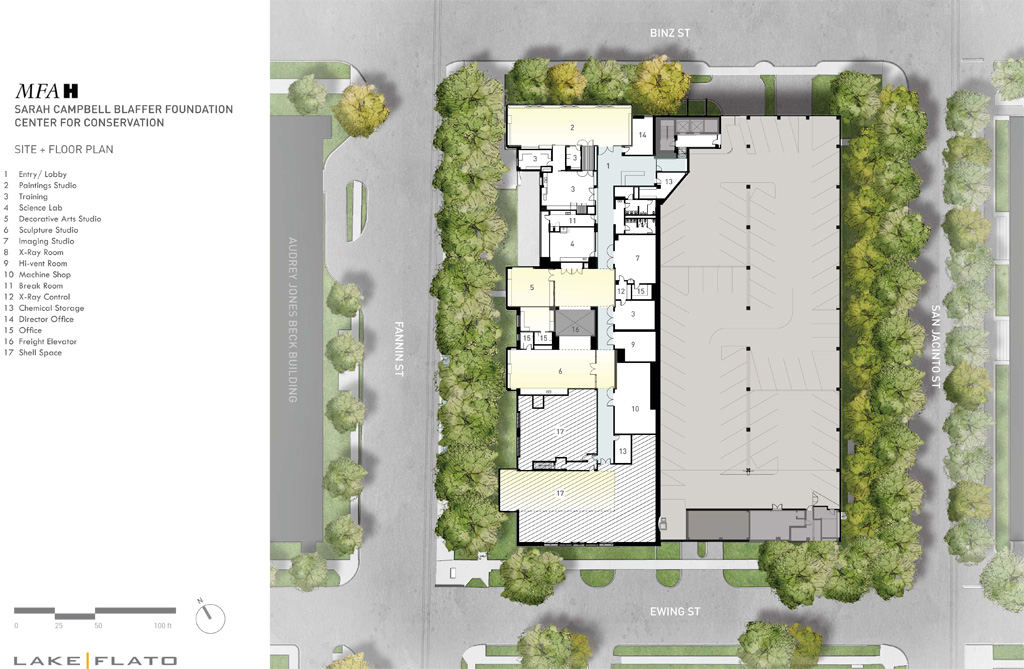
The Sarah Campbell Blaffer Foundation Center for Conservation Floor Plan. Courtesy of Lake|Flato.
Lake|Flato’s Design for the Sarah Campbell Blaffer Foundation Center for Conservation
The Blaffer Foundation Center was constructed at the eastern perimeter of the Museum’s Susan and Fayez S. Sarofim Campus, on top of an existing MFAH parking garage. The center is designed to consolidate conservation operations that for years had been dispersed miles apart. The site’s proximity to the curatorial offices across the street allows the conservation teams to collaborate closely with their curatorial colleagues in the care of the Museum’s collections of nearly 70,000 objects, spanning the ancient world to the present.
“The imperative was light,” said architect David Lake. “The design was driven by the concept of light as the organizing gesture, resulting in a central corridor that divides the day-lit studios from the spaces requiring darkness. With all of the mechanical support located on a floor below, we were able to free up ceiling space from ductwork and piping to create a soaring ceiling throughout.”
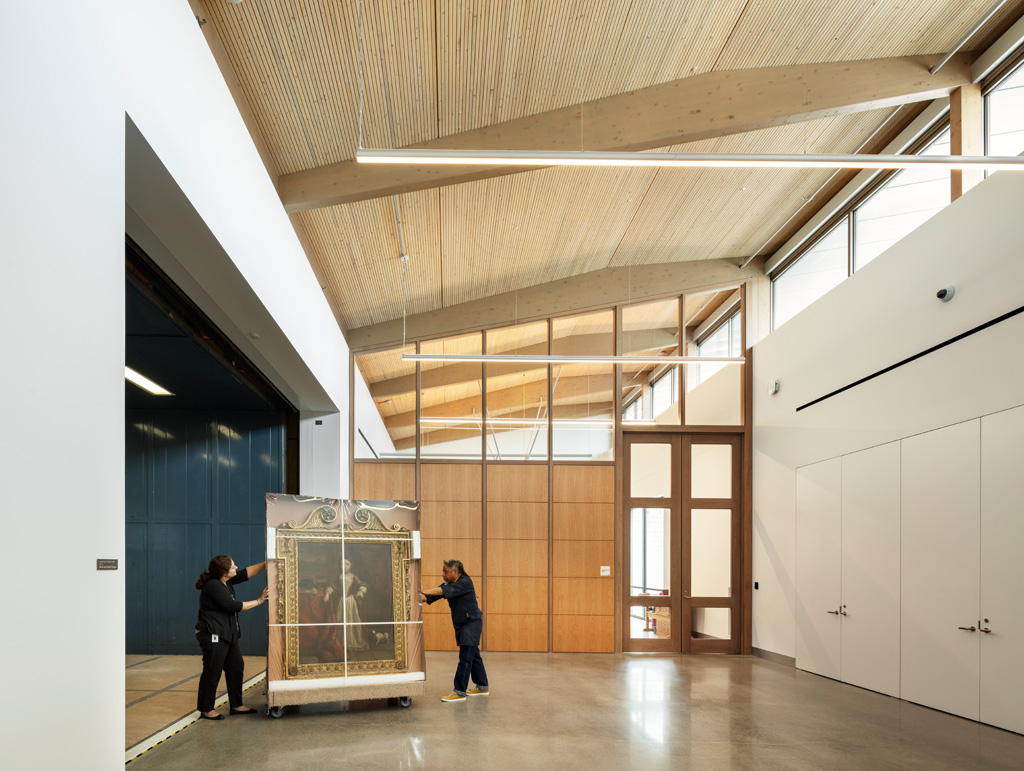
Freight elevator and Corridor inside the Sarah Campbell Blaffer Foundation Center for Conservation by Lake|Flato Architects. Photograph © Richard Barnes
From the exterior, the two-story structure appears as a series of four glass-and-steel boxes that cantilever out over the edges of the existing building. The studio bays are topped by a sloped roof and clerestory windows, which flood the interior with the indirect, north light that is so essential to conservators.
On the interior, a central corridor organizes the 24,000-square-foot studio floor. Four studio bays are sited along the outward side, one each for specific disciplines: painting, sculpture, textile, and decorative arts. Facilities requiring darkness, such as for imaging and x-ray studios, are on the inward side. Support spaces, including for framing and storage, are sited between the studios.
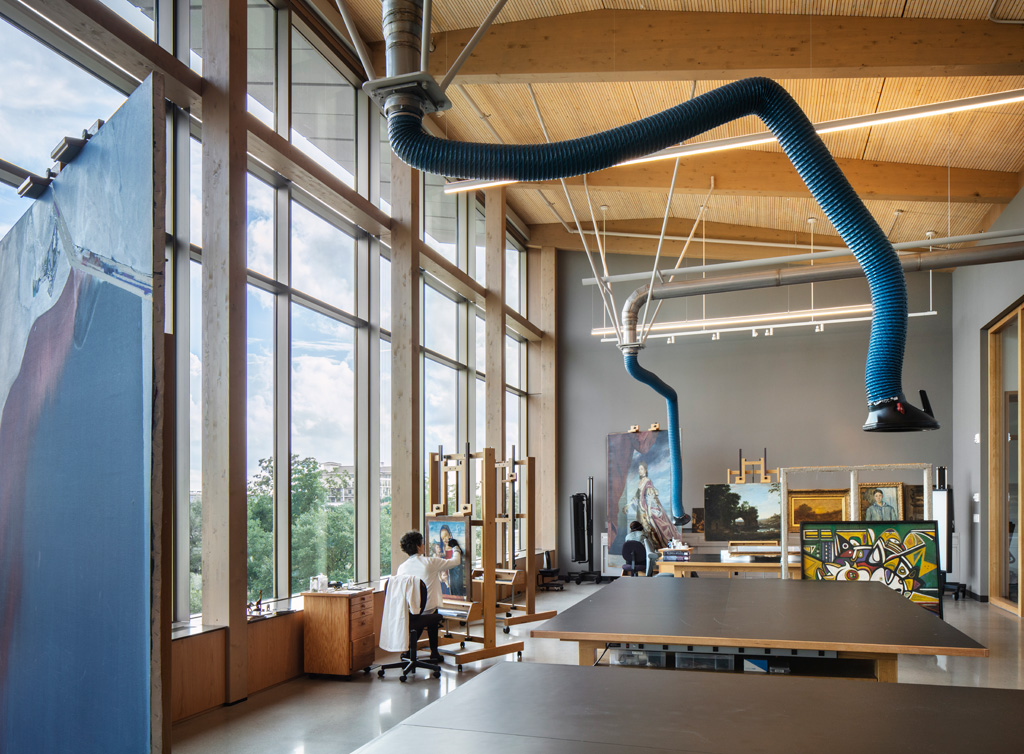
Painting studio inside the Sarah Campbell Blaffer Foundation Center for Conservation by Lake|Flato Architects. Photograph © Richard Barnes
All of the mechanical support systems are housed in 14,800 square feet on the floor below, allowing for a soaring ceiling height of up to 22 feet in the studios. Constructed from tightly packed Dowel Laminated Timber (DLT) panels, joined with dowels rather than nails, the ceiling’s efficient, sustainably harvested structural framing is among the first of its kind to be used in North America.
The Department of Conservation
The MFAH conservation department was established in 1997. Its initiatives encompass conserving all aspects of the Museum’s encyclopedic collections, deployed over five primary areas: paintings, decorative arts, sculpture and textiles, works on paper, and photographs. (The paper and photography conservation studio remains in its original location in the Museum, across the street from the new Blaffer Foundation Center.) The MFAH conservation department has also been a leading resource in disaster response, consulting to dozens of institutions after Hurricane Sandy in New York in 2012, as well as Hurricane Harvey in Texas and Hurricane Maria in Puerto Rico, both in 2017.
On an ongoing basis, the department’s conservators and research scientist conduct fundamental technical research, while curators and art historians collaborate with them to explore how objects were made and their subsequent histories; to assess questions of authenticity and attribution; and to consider the ethics and aesthetics of conservation and restoration approaches.
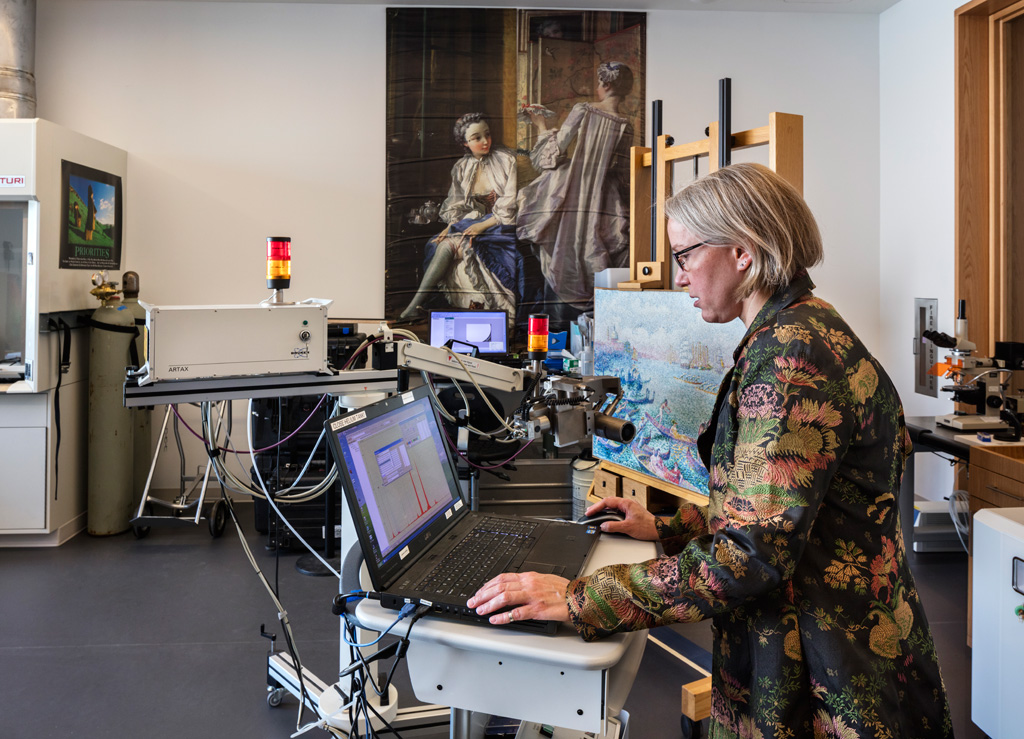
Science room inside the Sarah Campbell Blaffer Foundation Center for Conservation by Lake|Flato Architects. Photograph © Richard Barnes
Day-to-day, conservation staff evaluate objects from the collections that are brought in for analysis, research, or treatment; review works of art being considered for acquisition; and examine and acclimatize objects on loan from other institutions.
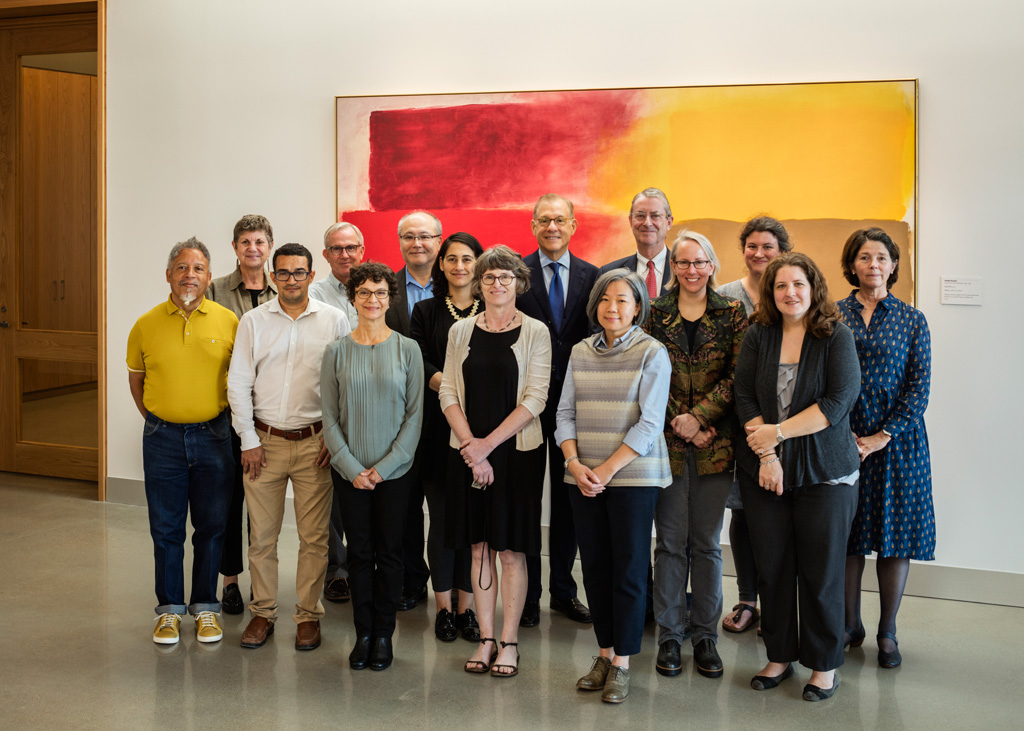
Members of the Museum of Fine Arts, Houston, conservation department with director Gary Tinterow inside the Sarah Campbell Blaffer Foundation Center for Conservation by Lake|Flato Architects. Left to right: Bert Samples, Karen Willis, Ivan Reyes Garcia, Steve Pine, Maite Leal, Toshi Koseki, Esmar Sullivan, Jane Gillies, Gary Tinterow, Tina Tan, David Bomford, Corina Rogge, Ingrid Seyb, Melissa Gardner, and Zahira Bomford. Photograph © Richard Barnes
Recent and upcoming conservation projects include a materials analysis of Franz Kline’s paintings, including the Museum’s 1950 Wotan, in collaboration with the Metropolitan Museum of Art, Harvard Art Museums, and other institutions; materials research on the paintings of Barnett Newman, conducted in collaboration with the Menil Collection; and a study of Brazilian Constructivist art from the Adolpho Leirner Collection at the MFAH, including works by Lygia Clark, Hélio Oiticica, and Alfredo Volpi.
Redevelopment Overview: The Susan and Fayez S. Sarofim Campus
Sited in the heart of Houston’s Museum District, the Sarofim Campus of the MFAH will be a major contribution to the city’s efforts to improve the pedestrian experience of Houston. With its generous array of public plazas, reflecting pools, and gardens, as well as improved sidewalks, lighting, and way finding, the campus provides an active setting for a century’s worth of architecturally significant buildings and three new structures: the Glassell School of Art, the Sarah Campbell Blaffer Foundation Center for Conservation, and the Nancy and Rich Kinder Building.
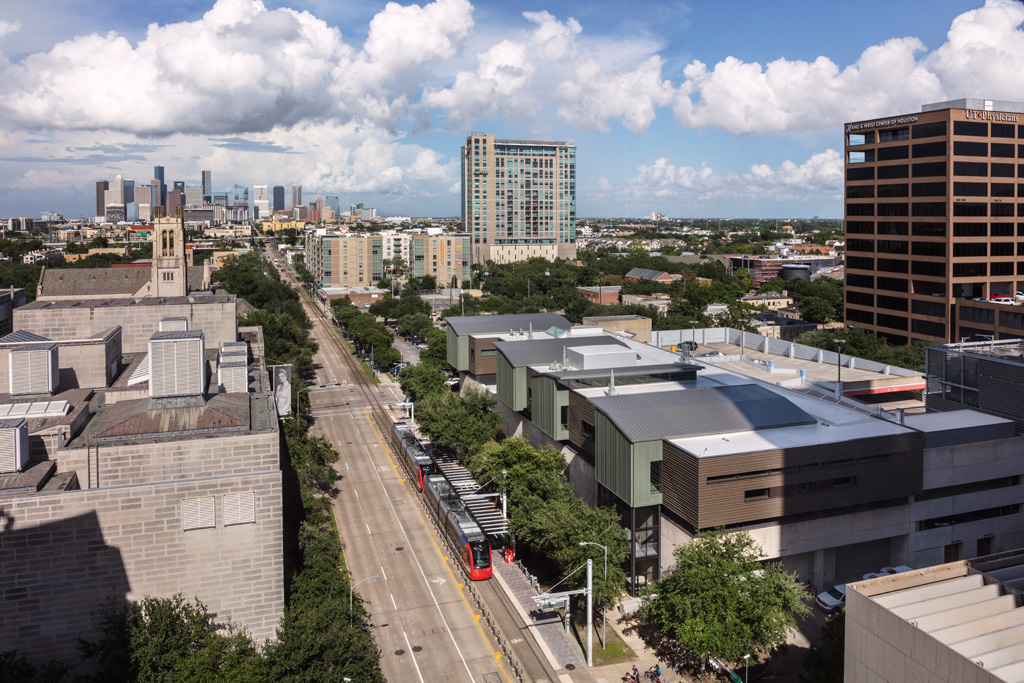
Back view of the Sarah Campbell Blaffer Foundation Center for Conservation by Lake|Flato Architects facing downtown Houston from the corner of Fannin Street and Ewing Street. Photograph © Richard Barnes
Lead support for the Sarah Campbell Blaffer Foundation Center for Conservation has been generously provided by the Blaffer Foundation. “Supporting the new conservation center was a natural fit for the Sarah Campbell Blaffer Foundation for many reasons,” said Joe Hudson, vice president and secretary of the Blaffer Foundation. “The Blaffer Collection has not only long been exhibited at the MFAH, but also cared for by the Museum’s world-class conservation team. We could not be more proud to continue our longstanding relationship with the Museum by partnering with the conservation department on this extraordinary initiative.”
The Blaffer Foundation Center opening marks the second complete phase of the overall project. The first phase of the project was completed in May 2018, with the inauguration of the new Glassell School of Art and BBVA Compass Roof Garden, designed by Steven Holl Architects; and The Brown Foundation, Inc. Plaza, designed by Deborah Nevins & Associates. The campus-redevelopment project is slated for completion in 2020. Follow the progress of the MFAH campus-redevelopment project at mfah.org/future.
About Lake|Flato Architects
Established in 1984, Lake|Flato Architects has gained national recognition by striving for architecture that is rooted to its place, responds to the natural environment, and merges seamlessly with the landscape. Lake|Flato Architects received the American Institute of Architects (AIA) Firm of the Year Award in 2004; earned a Texas Medal of Arts Award in 2009; and was named a finalist for a National Design Award by the Cooper Hewitt, Smithsonian Design Museum in 2010. In 2013, Fast Company magazine named Lake|Flato one of the World’s Top 10 Most Innovative Companies in Architecture. Lake|Flato received the Locus Foundation’s Global Award for Sustainable Architecture that same year, and in 2014 Ted Flato and David Lake, the firm’s founders, were inducted into the Interior Design magazine Hall of Fame. Eleven Lake|Flato projects have received the national Top Ten Green Projects Award from the AIA Committee on the Environment, the highest recognition for sustainable design. In all, Lake|Flato’s work has been recognized with more than 300 international, national, and regional awards. lakeflato.com
About the Museum of Fine Arts, Houston
Established in 1900, the Museum of Fine Arts, Houston, is among the 10 largest art museums in the United States, with an encyclopedic collection of nearly 70,000 works dating from antiquity to the present. The main campus comprises the Audrey Jones Beck Building, designed by Rafael Moneo and opened in 2000; the Caroline Wiess Law Building, originally designed by William Ward Watkin, with extensions by Ludwig Mies van der Rohe completed in 1958 and 1974; the Lillie and Hugh Roy Cullen Sculpture Garden, designed by Isamu Noguchi and opened in 1986; the Glassell School of Art, designed by Steven Holl Architects and opened in 2018; and The Brown Foundation, Inc. Plaza, designed by Deborah Nevins & Associates, Inc. and opened in 2018. Additional spaces include a
repertory cinema, two libraries, public archives, and facilities for conservation and storage. Nearby, two house museums—Bayou Bend Collection and Gardens, and Rienzi—present American and European decorative arts. The MFAH is also home to the International Center for the Arts of the Americas (ICAA), a leading research institute for 20th-century Latin American and Latino art. mfah.org



